 Fig 1. Body, dorsal view |
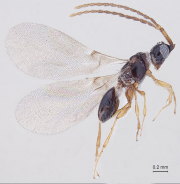 Fig 2. Body profile |
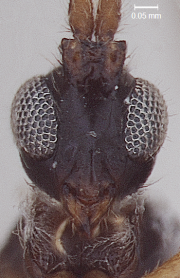 Fig 3. Head, front view |
|
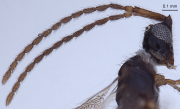 Fig 4. Antenna |
 Fig 5. Forewing |
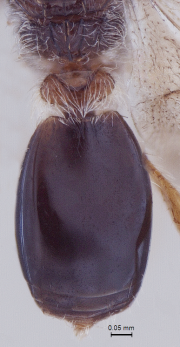 Fig 6. Metasoma |
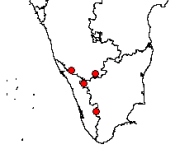 Fig 7. Distribution map |
|
Nomenclature
Claudivania Huggert, 1982: 183-200. Type species: Claudivania miranda Huggert.
Diagnosis
Small delicate forms (1-1.2mm), brown to blackish brown, appendages much lighter in colour, body smooth and shining, without any sculpture, depressed, lacking micropilosity, with sparse long semierect hairs, post gena and petiole without foam-like scaly structures. Hairy cushions dense on postgena, sides of pronotum, upper part of propleuron and petiole.
Head elongate nasiform, with ridge/ ledge dorsally. Antennal shelf projecting, highly raised above level of head. Female antenna 10-segmented with an abrupt and distinct 3-segmented clava. Mesoscutum and propodeum as two flat shields in same level, scutellum absent. Antennae clothed with irregularly scattered short pubescence, not as long as width of A2. Antennae in males elongate, filiform, with 14 cylindrical segments, often slightly constricted at both ends. A3 subequal in length to A4. A4 modified, slightly emarginate. Eyes with ommatidia distinct, with scattered pilosity, as long as those on frons. Malar space and temples longer than eye length. Occipital flange narrow, without crenuale. Mouthparts protruding beak-like, mandibles opisthognathous, feebly bidentate.
Cervix distinct. Pronotal shoulders rounded at sides, not angulate. Notauli deeply impressed, curved and diverging in front, not dilated posteriorly and not touching transscutal sulcus. Humeral sulcus very narrow, but distinct. Anterior scutellar pit monofoveate. Lateral and posterior scutellar pits much reduced. Sternaulus indicated. Dorsellum with three keels medially. Propodeum with three longitudinal keels, median area with sparse hairs, densely hairy laterally. Posterolateral corners of propodeum projecting. Metapleuron richly hairy. Nucha indicated.
Wings absent in females, but well developed in males, often large and broad. Venation complete, extending to nearly one-third of forewing length. Submarginal vein very close to forewing margin, costal cell much reduced. Both marginal and stigmal veins long, former nearly twice length of latter. Stigmal vein slanting. Postmarginal absent, basal vein pigmented, distinct. Marginal cilia well developed, but often never longer than only one-tenth forewing width. Hindwings with submarginal vein complete.
Petiole rather peculiar, with very broad circular median lobe in both sexes, often with a shallow V-shaped basal depression medially, extremely hairy. Metasoma slightly elongate, apex blunt. Anterior margin of T2/large tergite broadly concave in female, but straight in males, without a furrow or emargination. Basal tergites visible as simple strips.
Geographic Distribution
See distribution map (Fig.7).
Species known from India
1. Claudivania miranda Huggert
Remarks
Not common in collections. The genus is notable for its extent of sexual dimorphism, where females are visibly different from males. Females lack ocelli, eyes, scutellum and wings. While females have 10-segmented antennae having a distinct 3-segmented clava, male antennae are 14-segmented. Notauli distinct and scutellar pit monofoveate. The petiole is unique with a transverse hairy lobe medially. Forewing is unusually broad, the marginal cilia though well developed hardly one-tenth as long as forewing width.
References
|